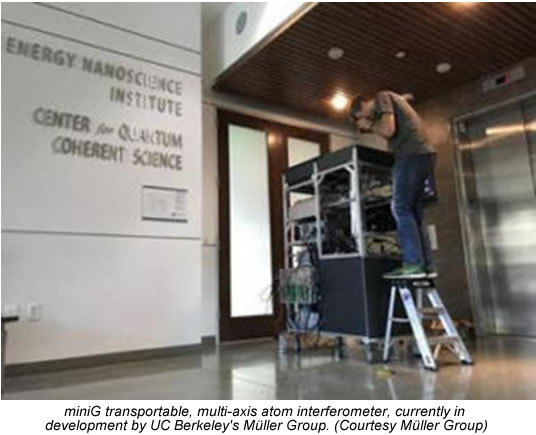 |
|
Professor Holger Müller's Group at UC
Berkeley is focused on advancing experimental quantum technology to push the
sensitivity of experiments to new levels, and to perform precision measurements
of fundamental constants. The groups work uses methods from atomic, molecular
and optical physics. One project is the development of a transportable,
multi-axis atom interferometer, named miniG.
MiniG was designed to
research how quantum interference can be used to measure gravity outside of the
laboratory. When cooled to just above absolute zero, the atoms form the focus
of a portable quantum gravimeter.
Gravimeters, used to measure
gravitational acceleration, have been successfully applied for metrology,
geology and geophysics. MiniG uses an atom interferometer to measure the effect
of gravity on clouds of atoms that are first trapped and cooled. Interferometry
inherently depends on the wave nature of the object. Particles, including
atoms, can behave like waves. Atom interferometers measure the difference in
phase between atomic matter waves along different paths.
We use atoms
that are laser-cooled to millionths of a degree above absolute zero, said
Xuejian Wu, a post-doctoral scholar, involved in the development of miniG at
the Müller Group. With pulses of light, we drive each atom into a quantum
superposition of having been kicked with the momentum of photons, or not
kicked. The atoms, in two places at one time, are in a superposition of
recoiling backwards or staying still. By manipulating the state of the atoms
using one of two types of such light pulses, we steer the matter waves' paths
and recombine the matter waves at the end of the experiment.
Atom
interferometry has become one of the most powerful technologies for precision
measurements, and atomic gravimeters, based on atom interferometry, are
extremely accurate and have long-term stability.
Current atom
interferometers, however, are too complicated to operate in a miniature package
or under field conditions. Berkeleys mini-G was engineered to resolve this
issue.
In this project, we are developing a mobile atom interferometer
using a single-diode laser system and a pyramidal magneto-optical trap,
continued Wu. This allows the device to be smaller, simpler and more robust
than conventional atom interferometers.
Vibration
Isolation
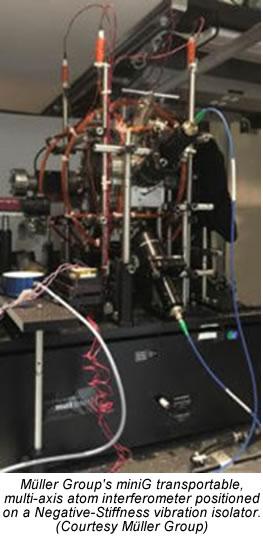
Measurements of atomic precision require
isolation from ambient vibrations coming from internal and external sources. As
measurements are being done at a smaller and smaller level, those vibrations
that are present will start to dominate, and the need for more effective
isolation increases.
Although the Müller Groups research
laboratory is situated in the basement of a building on the Berkeley campus, it
is still influenced by vibrations from the buildings HVAC system.
For
several years now we have been using
Negative-Stiffness vibration isolation for our
research projects, continued Wu.
Full article...
|
 |
|
The United States Bowling Congress
(USBC) is the national governing body of bowling, as recognized by the United
States Olympic Committee. It is a membership organization that provides
standardized rules, regulations and benefits for certified bowling leagues and
tournaments. The USBC is one of the worlds largest sports and recreation
membership organizations, in the United States serving approximately 1.4
million bowlers that participate in USBC-certified leagues and tournaments on
both the national and local levels.
Critical to the initiatives of the
USBC is its Department of Equipment Specifications and Certification, which
encompasses testing and research of bowling equipment to set standards and
enhance the sports credibility.
“There are two sides to bowling
– the recreational, and the more competitive,” said Tom Frenzel,
Research Engineer with the USBC. “Our focus is on research, testing,
standardization and certification of bowling equipment used for leagues and
tournaments.”
“Basically, any piece of equipment that
touches the bowling lane comes though this department to be evaluated, and
determined whether or not it should be allowed to be used,” added Frenzel.
“This includes bowling pins, bowling balls, lane panels, lane
conditioners, gutters, and kick-back walls in the pin deck.”
To this end, the department uses a number of research and testing
methodologies to ensure that not only do these products meet established
specifications, but that they are manufactured to within a 4 Sigma quality
manufacturing limit, which means within a 0.6 percent defect rate. Essentially,
ensuring that 99.4 percent of all bowling products used for certified leagues
and tournaments are within designated specifications.
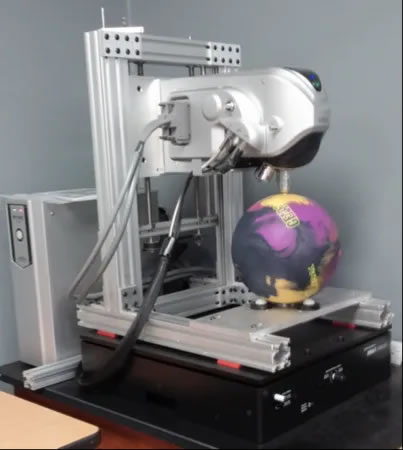
Minus K
Negative-Stiffness vibration isolator,
under a 3D laser-scanning, digital
confocal microscope.
Surface Roughness of Bowling
Balls
One area of ongoing research and testing at USBC concerns surface
roughness of bowling balls.
Since the early 1990s, better bowling ball
coverstocks have been developed. These coverstocks find more friction on the
lane, and inevitably hook more. They also disrupt the oil pattern on the lane
more, which tends to reduce friction. So the USBC engineering team is trying to
better understand the implications of these factors, and better control their
outcomes.
It has become popular to sand bowling balls with different
grits of sand paper, explained Frenzel. This practice has helped us see how the
sanding level on a ball affects its surface layer, then we compare this back to
how it performs on the lane.
The rougher you get the ball, the more the
ball will hook, and the more friction it will find, continued Frenzel. The
friction will define how the ball accelerates. So more friction means more
acceleration, which just means it is changing its speed quicker, or in less
time. It is really hooking sooner versus later, or taking less time to
hook.
Full article...
|
|
(2007 legacy article) - Whether it's an NMR
or a two-photon microscope, scientists love toys - at least when they work.
Sometimes the most mundane things bungle technology: environmental
vibrations from cars driving by, central air conditioning, the voices of the
operators, and even the ocean. As instruments become more sensitive,
subsonic rumblings become more insidious, particularly for nano-technology
applications. With many instruments, such as atomic-force and electron
microscopes, cutting down on vibration is essential to collecting good data.
"You could spend a million or two million on a microscope and have it rendered
useless because of vibration," says Kurt Alberline, an anatomist at the
University of Utah School of Medicine, who runs an electron microscopy
lab.
When researchers suspect vibration is wreaking havoc on their data,
they should identify the origin of the noise or get an environmental engineer
to find it, say scientists who regularly deal with vibration. For example,
Vicki Colvin, a chemist at Rice University in Houston, noticed images moving
around in a circle on her transitional electron microscope. "It was like a
ghost," she says. Colvin discovered that an air duct was causing the problem
and spent $1.20 on a shield to divert air away from the scope. "The easiest way
to get rid of vibrational noise is to stop it at its source." says Larry Cohen,
a neuroscientist at Yale University.
The design of a building is
critical to the vibration that reaches an instrument, says Ahmad Soueid, senior
vice president at HDR Architecture in Omaha, Neb., which has designed more than
a dozen nanotech laboratories. Isolating air-handling equipment from
laboratories and using special joints that redirect vibration to the ground are
some of the fixes his firm uses. Recently, concerns over vibration plagued a
$250 million NIH facility under construction in Baltimore. Initial reports
indicated the building's quivers could render confocal microscopes useless,
although later measurements suggested most instruments will work with proper
dampening
There's no universal fix, says David Platus, president of
Minus K, a company that makes high-end vibration-isolation tables. Solutions
vary, from cheap rubber pads that rest under instruments, to the air-cushioned
tables that have been around for 50 years, to tables that sense vibration and
cancel it out. "The more sensitive the instrument, the better isolation you
need." he says.
Full article...
Example Causes of Bad
Vibrations:
Automotive
Buildings
Columns
Computers
Elevators
Engines/Motors
Floors
Freeway & Road Traffic
Generators
HVAC (Heating & Air Conditioning Issues)
Machinery
Mechanical Entities
Plumbing, Piping
Pneumatic factors
Seismic Waves
(including from ocean waves)
Trains & Subways
Transformers
Winds
Against Buildings
(Examples with
Hz...)
|
|
Vibration Isolation for Heavy
Payload Systems
Minus K vibration isolation systems can be
designed for very heavy payloads. The following are some typical isolator
dimensions. The 10,000 lb and 25,000 lb isolator dimensions are approximate and
are based on preliminary designs.
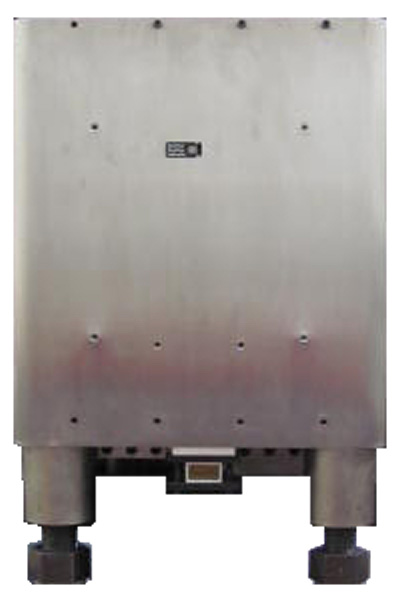
XM-1:
10,000 lb capacity: 20"W x 20"D x 22"H
The James Webb
Space Telescope is the largest cryogenic instrument telescope to be developed
for space flight. It is a large-aperture infrared space telescope and the
scientific successor to NASA's Hubble Space Telescope and used a set of six
custom heavy capacity Minus K vibration isolators for ground testing.
The ground testing confirmed the telescope and science instrument
systems will perform properly together in the cold temperatures of space.
Additional test support equipment including mass spectrometers, infrared
cameras and television cameras were also supported by Minus Ks heavy capacity
vibration isolators which allowed engineers to observe the testing.
Each of the isolators was designed for 10,000 lbs. and the total
payload supported from the top of the Johnson Space Center vacuum Chamber A was
60,000 lbs.
The isolators allowed NASA to simulate the telescopes
performance in space while preventing all the ground-based disturbances, such
as the pumps and motors, and even traffic driving by from interfering with the
ground testing. Case
study:
NASA James Webb Space Telescope
(JWST).
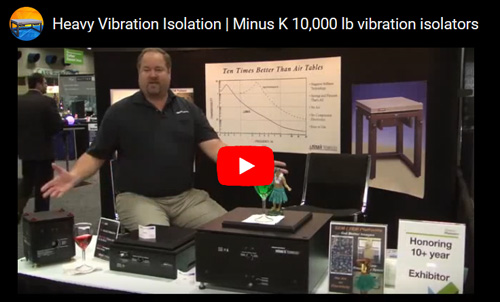
|
Press
Release: Minus K Receives Laser
Focus World Innovator Award for
Ultra-Thin, Low-Height
CT-1
Vibration Isolation Platform

The awards
were given to companies or organizations that demonstrated
excellence in a
product or technology,
an application, or in research and development.
(November 25, 2019,
Inglewood, California) - For the second year, Laser Focus World held its
Innovators Awards program, which celebrates the disparate and innovative
technologies, products, and systems found in the photonics market. The awards
were given to companies or organizations that demonstrated excellence in a
product or technology, an application, or in research and development.
Full
release...
 |
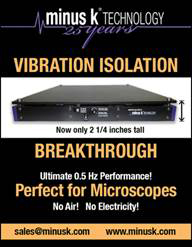
 |
|
Vibration Criterion (VC)
Curves-Lab Analysis
Codes and curve descriptions for different
vibration environments and solutions.
The VC
(Vibration Criteria) curves were developed in the early 1980s by Eric Ungar and
Colin Gordon. They were originally developed as a generic vibration criteria
for vibration-sensitive equipment for use in the semiconductor, medical and
biopharmaceutical industries, but have found application in a wide variety of
technological applications.
The criteria takes the form of a set of
one-third octave band velocity spectra, together with the International
Standards Organization (ISO) guidelines for the effects of vibration on people
in buildings. The criteria apply to vibration as measured in the vertical and
two horizontal directions.
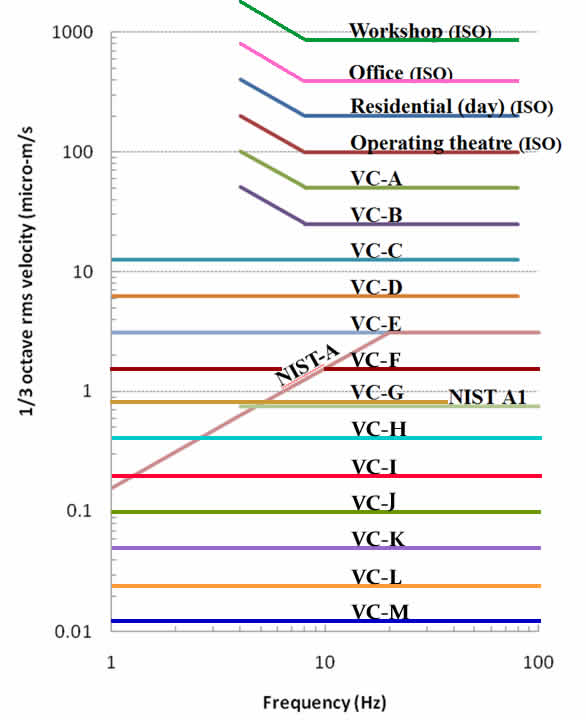
The
NIST-A criterion was developed for metrology, but has gained popularity within
the nanotechnology community. The NIST-A criterion is a very difficult
criterion to meet at some sites with significant low-frequency
vibrations.
The VC curves are now widely accepted throughout the world
as a basis for designing a facility to meet the requirements of a group of
highly vibration sensitive equipment used close together.
University of
Michigans Ultra-Low Vibration Lab (ULVL) was completed in 2014. After the
construction, a vibration survey was done on the Ultra-Low Vibration Lab
chambers. The measurements demonstrated that even when a single vehicle was
driving on a nearby street, the vibrations exceeded the NIST-A specifications
necessary for the ULVL.
The University of Michigan ordered seven
customized tabletops and 31 custom Minus K Negative-Stiffness vibration
isolators with pedestals provided for the eight Ultra-Low Vibration Lab
chambers.
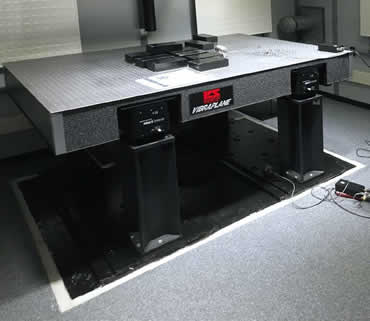
Customized Minus K
Technology Negative-Stiffness vibration isolation table installed in one of the
Ultra-Low Vibration Lab chambers
The
final vibration survey by Colin Gordon Associates (CGA), after installation of
the customized Minus K Negative-Stiffness isolators and tables, showed the
measured vibration levels in all ULVL chambers from VC-K to VC-M at frequencies
above 2.5 Hz, well below the NIST-A Vibration Criterion required.
"VC-M
is the lowest we have ever measured, though we werent able to measure below 2.5
Hz because our most sensitive sensor wont go lower, due to sensor noise floor,"
said Hal Amick, Vice President of Colin Gordon Associates.
The updated
VC Curve on Minus K's
website shows these lower curve levels that were measured by CGA
and have already assisted University of Michigans ULVL with two major
scientific milestones.
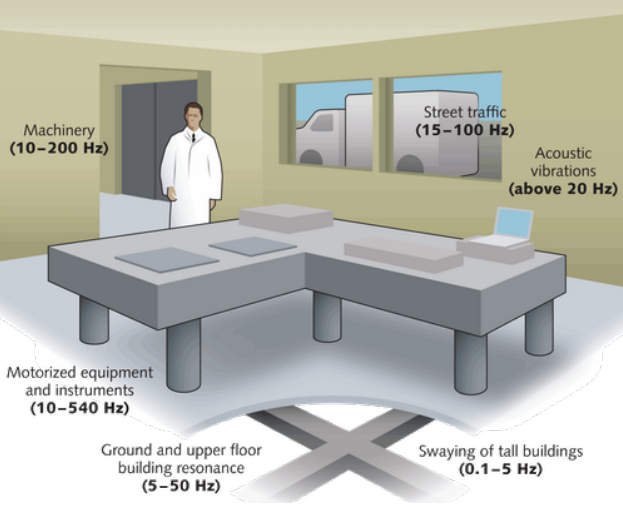
Vibration site surveys can tell you a
lot about how to
specify equipment for vibration isolation in your
laboratory.
Updated
VC Curve on Minus K's website... |
Previous
Features:
How They
Work>>Negative-Stiffness Vibration Isolators
Microscopy Vibration
Isolation
FAQs>>Frequently Asked
Questions About Vibration Isolation
Custom Vibration Isolation
Systems
Audio Reproduction & Turntable
Vibration Isolation
Vibration Isolator Steadies Optics
for NASA Telescopes + Vacuum Isolation
Optical-Laser Vibration Isolation +
video
Optical-Laser Vibration Isolation +
video
Cryostat Vibration
Isolation
Nanoindentation & Micro Hardness
Testing
Vibration Isolation
Ultra-Low Frequency Vibration
Isolation Stabilizes Scanning Tunneling Microscopy
Neuronal Research into Animal
Learning, Memory Neuronal Research,
Vibration Isolation Problem &
Solution
Sunken Treasure Surrounding The
Coldest Cubic Meter In The Universe
Supported by Minus K Vibration
Isolators
Lithium Batteries: Superionic Solid
Electrolytes for Next-Generation
Spacecraft Vibration Isolation On the
Ground
Behavior of a Single Molecule-UCLA's
California NanoSystems Institute
Cleanroom Precision Vibration
Isolation
Negative-stiffness vibration
isolation is utilized to provide ultra-stability for multi-disciplined,
nano-level research at UCLA's California NanoSystems
Institute.
NASA/JWST Update: Custom James Webb
Space Telescope Vibration Isolators Working Well
Audiophile Interests: The Doehmann
Helix 1 Turntable
Minus K Technology Educational
Giveaway to U.S. Colleges and Universities
Articles In The
News
|
